08/04/2025
The World Intellectual Property Organisation (WIPO) has recently released its report on technology trends in the future of transportation, and our previous spotlights have looked into the trends for trade marks and registered designs. In this piece, we will be turning our attention to patents, which have seen an even higher rate of growth in the number of filings over the last 20 years than those for trade marks and registered designs.
Putting aside the rate of growth, the patent statistics follow a similar trend to that of trade marks and registered design filings whereby China dominates in the total number of filings, but other countries take the top spots for the individual companies that are the most active filers. In fact, it is Japanese companies that are leading the way on patenting future transport technologies, with the top four patent filers all being based in Japan, as well as six out of the top eight filers.

Figure 1: Top patent owners based on the number of patent families, 2000-2023. Source: WIPO (2025). WIPO Technology Trends Report 2025: The Future of Transportation. Geneva: World Intellectual Property Organization. DOI:10.34667/tind.57963
The patent filing from China appears to be clustered around numerous universities and research institutes at this stage, but it will be interesting to see if this balance changes given the trend that can be seen in Figure 2 below whereby the patent owners with the two largest increases in publications of patent families are both Chinese companies, and many other Chinese companies also showing strong increases.
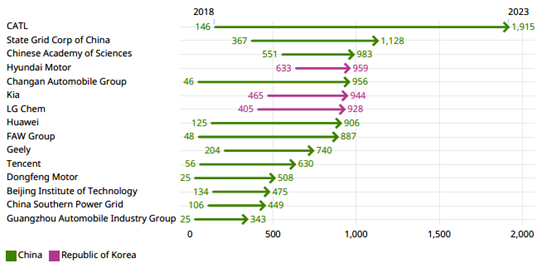
Figure 2: Patent owners with the largest increase of patent family publications, 2018-2023. Source: WIPO (2025). WIPO Technology Trends Report 2025: The Future of Transportation. Geneva: World Intellectual Property Organization. DOI:10.34667/tind.57963
If technology being patented is expected to be successful, it is reasonable to anticipate that protection for the same concept will be sought outside of the inventors home jurisdiction (since patents are territorial rights and can only protect activity in the jurisdiction in which protection has been sought). These groups of patent applications for the same concept are typically referred to as patent families and, where the filing span multiple jurisdictions, they will be referred to as international patent families in the following discussion.
By filtering the count to the number of international patent families, and splitting the future transport filings by modality, which the report segregates as land, sea, air, and space, the geographical spread of filings (by inventor location) reveals a very different picture as can be seen from Figure 3 below. While China holds onto second place for the international patent family filings in the air and space modalities, the US takes the lead for the sea, air, and space modalities with Japan in pole position for the land modality as discussed above.
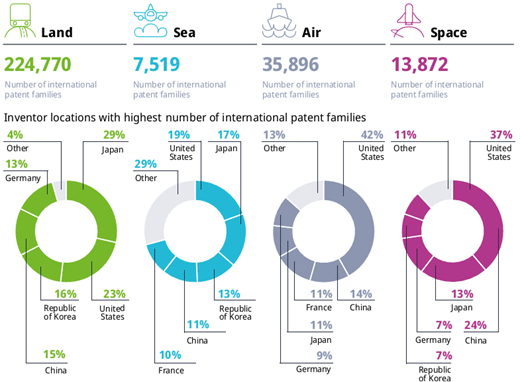
Figure 3: Exploring international patent families in the four transport modalities, 2014-2023. Source: WIPO (2025). WIPO Technology Trends Report 2025: The Future of Transportation. Geneva: World Intellectual Property Organization. DOI:10.34667/tind.57963
One explanation for this change is that universities and research institutions, which dominated the Chinese numbers in Figure 1, may be less likely to have the funds for extending patent filings into international families. However, it is also worth noting that, while these have now been phased out, the Chinese government provided various subsidies for patent filings for the vast majority of the timeframe covered by these statistics, and so this may have overinflated China’s quantitative dominance for the period.
Another statistic to note from the report shows that China has the highest number of litigated patents in the field of the future of land transport, with the US a close second; however, due to the dilution of the number of filings in China, the ratio of US litigated patents in the field of the future of land transport was found to be three times higher than that of China. It will be interesting to see how all of the above statistics change as the Chinese government continues to progress away from these patent subsidies, with the stated aim being to shift China’s focus from improving the quantity of Intellectual Property (IP) to improving IP quality.
Figure 3 also highlights the varying levels of geographic diversity for future transport inventor locations across these modalities. While I would have anticipated the sea modality being the most diverse (with 29% of international patent filings originating from countries outside of the top 5 filers), I was surprised to see the land modality having the most concentrated filing (with only 4% of international patent filings originating from countries outside of the top 5 filers) rather than one of the air or space modalities.
While UK inventors do not appear in any of these top 5s for filing numbers, it is reassuring to see in Figure 4 that we have the second best conversion rate for international patent families across each of the land, air, and space modalities – i.e. the proportion of first patent filings that are pursued in other countries to become international patent families – which can be seen as an indication of the quality of inventive output coming from the UK.
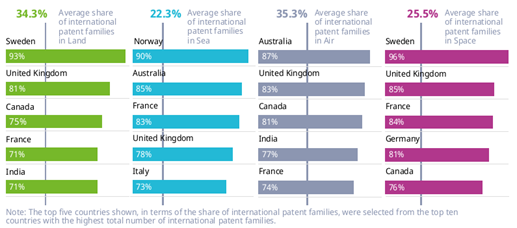
Figure 4: Share of international patent families within the top inventor locations for the four transport modalities, 2014-2023. Source: WIPO (2025). WIPO Technology Trends Report 2025: The Future of Transportation. Geneva: World Intellectual Property Organization. DOI:10.34667/tind.57963
If we focus on the statistics for the future of land transportation, it is unsurprising to see that the vast majority (approximately 78%) of the patent family filings are for battery technology. Electric vehicles are dominating the development landscape and improvements in battery technology are seen as key to improving the experience of electric vehicles, both to allay any range anxiety fears, and also reduce the battery mass / charging time needed for this.
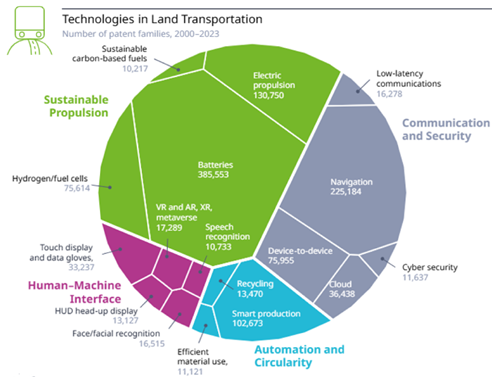
Figure 5: Exploring the patent landscape in land transportation across technology trends, 2000-2023. Source: WIPO (2025). WIPO Technology Trends Report 2025: The Future of Transportation. Geneva: World Intellectual Property Organization. DOI:10.34667/tind.57963
Following this line of thought it can be seen how, by developing in-house battery production as well as developing both electric and hydrogen fuel cell vehicles, Toyota has been able to fuel a significant patent filing program and accelerate away from the competition in terms of patent family filings for sustainable propulsion in land transportation technologies, maintaining a lead of nearly three times that of Panasonic, its closest competitor according to the statistics.
The report classifies the four primary technology trend clusters within transportation as Sustainable Propulsion, Automation and Circularity, Communication and Security, and Human–Machine Interfaces, and it appears from the charts of Figure 6 that the further you get away from land, the less important (or perhaps less easy) sustainable propulsion becomes and the more important communication and security technologies become as the focus turns to those technologies that enable secure and reliable communication between vehicles, infrastructure and users.
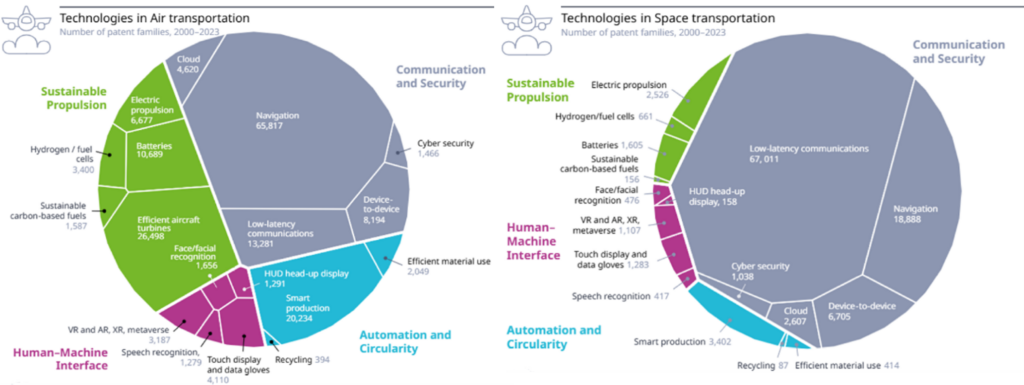
Figure 6: Exploring the patent landscape in the air and space transportation modalities across technology trends, 2000-2023. Source: WIPO (2025). WIPO Technology Trends Report 2025: The Future of Transportation. Geneva: World Intellectual Property Organization. DOI:10.34667/tind.57963
While the patent filings are relatively balanced between sustainable propulsion and communication and security technologies for air transportation in countries such as the UK, France (which has the highest relative specialisation for patent filings in the air transport industry due to big players such as Airbus and Safran), and the US, the numbers are swung in favour of communication and security by a high focus in this area in Chinese patent filings (more than four times that of sustainable propulsion). However, despite the number of Chinese originating communication and security patent families being more than twice that of the US in second place, there are no Chinese companies in the top 3, whereas Boeing and Honeywell International take the first and third place respectively. This again illustrates the concentration of patent filings in the big players in countries such as the US, where this does not appear to be the case for China.
For space transportation, communication and security technologies truly dominate at over 85% of filings, and China again has more than twice the number of patent families than that of the US which takes second place, whereas the commitment to sustainable propulsion technologies in space transportation is roughly the same between the two countries. What caught my eye here though is that the UK emerges as the country with the highest growth in patent filings for sustainable propulsion technologies in space transportation over the period of 2018 to 2023, and that this is more than twice the growth of China in second place. It will be exciting to see the UKs continued growth in space sector technology, which has an evolving IP landscape. Indeed, it is becoming increasingly important for the emerging space technology companies to understand the challenges to securing IP beyond national (and planetary) borders.
At Reddie & Grose we work with clients at the forefront of innovation – if you would like assistance with your IP strategy then please get in contact. We have a multidisciplinary team of attorneys focused on Future Transport that can assist you with invention harvesting and patent filings across this area.
This article is for general information only. Its content is not a statement of the law on any subject and does not constitute advice. Please contact Reddie & Grose LLP for advice before taking any action in reliance on it.



